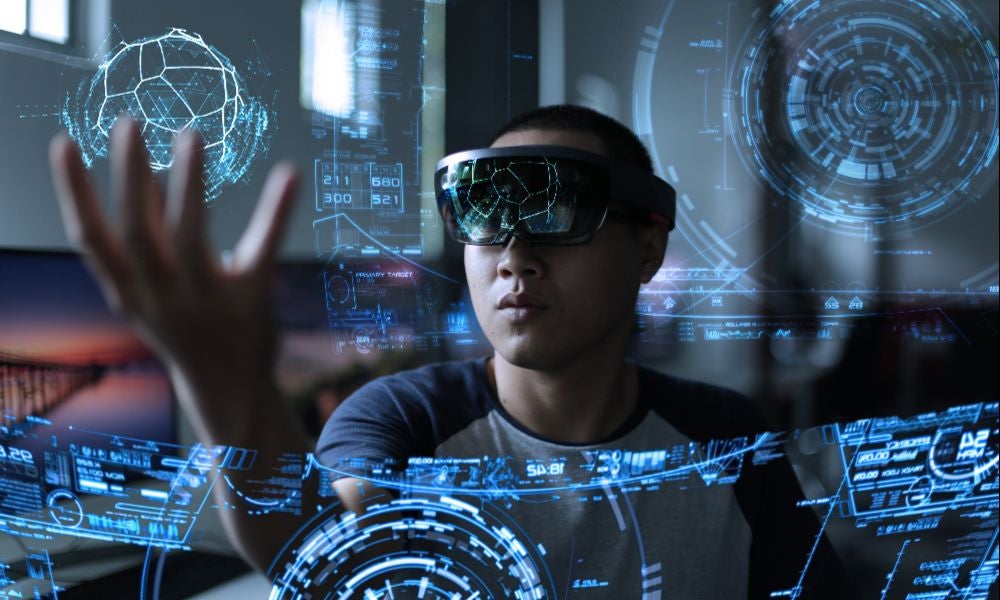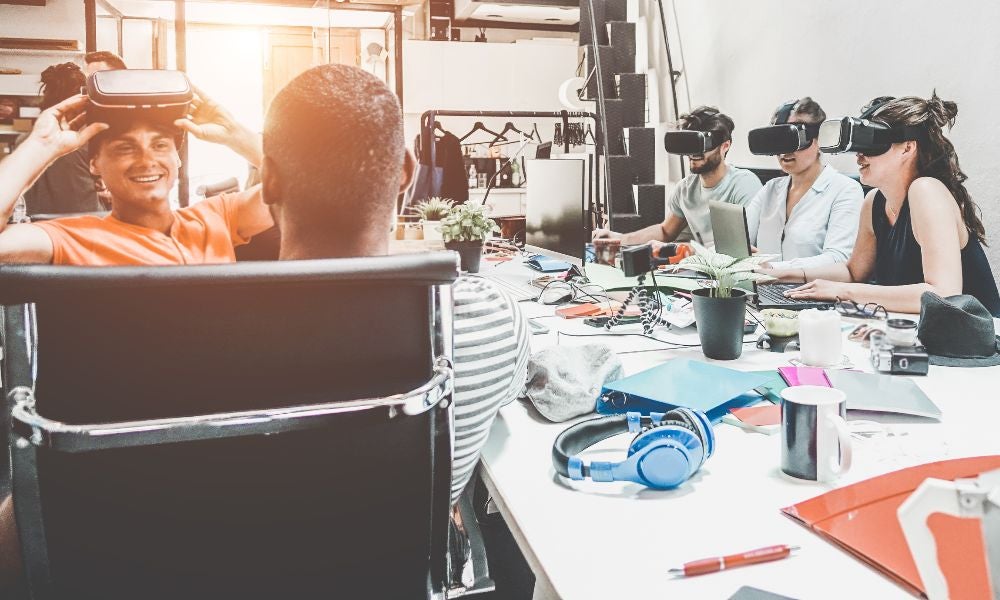How businesses can design VR simulations to enhance inclusivity
Virtual reality (VR) technology can significantly enhance inclusive education and help reduce disability-related inequalities in workplaces and educational environments
Virtual reality (VR) technology is transforming education by promoting workplace inclusion for people with disabilities. Research from UNSW Business School demonstrates exactly how well-designed immersive VR experiences can effectively foster understanding, empathy, and real-world inclusion. For business leaders, combining first- and third-person VR perspectives is particularly powerful.
UNSW Business School Associate Lecturer Xinyue Zhang, lead author of the research, explains: “The first-person perspective allows individuals to experience exclusion directly, while the third-person perspective offers insight into broader social dynamics and helps to reduce the motion sickness associated with VR. Together, these views enhance emotional engagement and the immersion experience, and encourage critical reflection on behaviours, environments, and group interactions.”
In her paper, Designing an immersive virtual reality artefact for disability inclusion: an action design research, Dr Zhang presents an insightful case study exploring how immersive learning through extended reality, encompassing virtual reality, augmented reality, and mixed reality, can effectively highlight social barriers encountered by individuals with impairments. Co-authored with academics from UNSW Business School, Scientia Professor Shan L Pan, AGSM Scholar and Deputy Head of School for Research, and Associate Professors Yenni Tim and Veronica Jiang from the School of Information Systems and Technology Management, the paper offers several insights for future research and initiatives in human-computer interaction.

Dr Zhang explained: “The study revealed that immersive VR, when co-designed with people with disability, can shift user attitudes and behaviours by turning abstract inclusion concepts into emotionally resonant lived experiences and actionable behaviour takeaways.”
Immersive learning and extended reality: a case study
The research initially started in collaboration with the UNSW Disability Innovation Institute. The researchers aimed to leverage educational technology and VR headsets' visualisation capabilities to represent the lived experiences of people with disabilities more authentically. Existing literature reviews of disability advocacy highlighted significant limitations in current methods, motivating researchers to pursue innovative approaches involving immersive VR content.
“Although most disability advocacy tools are effective at the exposure level by enhancing basic awareness, they are found to be less effective when it comes to fostering empathy and ownership, with some, such as disability simulation exercises, even being criticised for reinforcing negative stereotypes and promoting pity rather than empathy towards people with disability," said Dr Zhang.
In their study, the researchers conducted in-depth interviews with 23 learners recruited through prominent Australian disability organisations such as the Cerebral Palsy Alliance, PeepsRide, and the UNSW Disability Innovation Institute. These discussions revealed that the most significant barriers were societal rather than physical – such as inaccessibility, stereotypes, and exclusionary behaviours – highlighting how social structures and environments primarily shape the experience of disability.
Learn more: Empowering diverse teams: six characteristics of inclusive leaders
“Working alongside media professionals, VR experts, and individuals with disabilities, the research team co-created immersive avatars and scenarios designed to facilitate realistic role-play experiences," said Dr Zhang. “People with disabilities actively contributed at every stage, from initial concept and storyline development to filming and user-experience evaluation, enhancing authenticity and significantly improving the educational impact of the VR simulations.”
From this design experience, the research team hoped to uncover how immersive technologies such as VR could be co-designed with people with disability to authentically reflect their social experiences and provide practical guidance for designing more empathetic and inclusive learning tools.
Central to the project was a collaborative industry partnership with NOVA Employment, a provider of inclusive employment initiatives. NOVA supplied essential data and actively promoted the VR project internationally through its Focus on Ability Film Festival. The collaboration provided narrative content (Riding with Amy), real-world business contexts via student-developed marketing strategies, large-scale user testing through integration into UNSW Marketing courses, and consistent co-design input from NOVA staff.
This partnership inspired and served as the platform for implementing and evaluating the immersive VR experience. The resulting research formalised educational innovations and validated the practical impact achievable when higher education integrates business experience with evidence-based learning.

Dr Zhang said: “NOVA’s involvement grounded the research in real-world challenges and ensured that the design process aligned with the lived experiences of people with disability and the practical needs of inclusive employment.”
Four design principles for effective VR education
The researchers outlined four essential design principles beneficial to various sectors, including businesses, healthcare, education, and training providers interested in leveraging VR and AI for inclusive practice. These principles highlight the critical role of immersive technologies and thoughtful user experiences in advancing disability inclusion and societal understanding.
Importantly, the research identified that social barriers such as inaccessibility, stereotypes, and exclusionary behaviours were more impactful than physical limitations on the participation of individuals with disabilities. Aligning with the social model of disability, which emphasises societal rather than medical determinants of disability, this insight became foundational to the project's methodology.
Overall, the close collaboration among stakeholders ensured meaningful engagement, robust educational outcomes, and significant real-world impact, demonstrating the potential of immersive VR technologies to foster inclusion and empathy.
Subscribe to BusinessThink for the latest research, analysis and insights from UNSW Business School
Specifically, the paper identified four clear design principles essential for developing compelling VR learning experiences:
1. Exposure must be authentic and information-rich. Abstract messages and token gestures undermine many inclusion initiatives. The first principle emphasises creating authentic virtual scenarios depicting real-life social barriers faced by individuals with disabilities, from inaccessible environments to unconscious biases. The researchers noted that "a lack of disability knowledge is a key challenge”.
Businesses can overcome this challenge by designing VR modules with informational overlays, narrative contexts, and compelling visual storytelling that intellectually and emotionally engage users.
2. Engagement requires interactivity and accessibility. While simply exposing users to scenarios is not enough, effective VR experiences must incorporate interactive elements that enable real-time decision-making to enhance engagement and knowledge retention. These experiences should encourage active, autonomous participation to deepen understanding – particularly of complex topics like disability.
However, to avoid cognitive overload and ensure accessibility, especially for VR novices, interactions must be thoughtfully designed to guide attention. The paper recommends that businesses move away from passive modules and adopt immersive, interactive scenarios that reflect real-life challenges without overwhelming users.

3. Empathy is engineered through perspective-taking. The third principle underscores the creation of empathy through first-person perspectives, enabling users to experience scenarios from the viewpoint of someone facing inclusion or exclusion.
The study recommends incorporating third-person perspectives, allowing users to observe interactions critically from an external viewpoint. This dual perspective approach enhances reflective understanding of social dynamics and reduces motion sickness, broadening content accessibility.
4. Empowering empathy into action. However, awareness alone isn't sufficient; users must feel empowered to act inclusively. The fourth principle advocates designing VR experiences where users make choices, experience outcomes, and gain confidence in inclusive behaviours.
Scenarios that showcase the outcomes of inclusive versus exclusive actions help users reflect on their role and ability to foster inclusion. Therefore, businesses should adopt this principle by creating training tools that actively simulate inclusive behaviours, allowing employees to practice responses in ethically and socially challenging situations.
